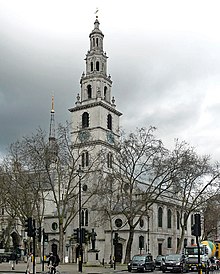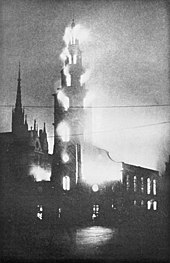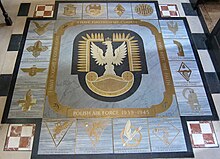St Clement Danes
| St. Clement Danes | |
|---|---|
 | |
| Location | City of Westminster, London |
| Country | United Kingdom |
| Denomination | Church of England |
| Previous denomination | Roman Catholic |
| Churchmanship | Modern Catholic |
| Website | www.raf.mod.uk/our-organisation/units/st-clement-danes-church |
| Architecture | |
| Heritage designation | Grade I |
| Architect(s) | Christopher Wren |
| Style | Baroque |
| Years built | several, most recently 1682 |
| Administration | |
| Diocese | Diocese of London |
| Clergy | |
| Chaplain(s) | The Revd David Osborn |
| Laity | |
| Director of music | Simon Over |
| Business manager | Sharon Hardwick |
St Clement Danes is an Anglican church in the City of Westminster, London. It is situated outside the Royal Courts of Justice on the Strand. Although the first church on the site was reputedly founded in the 9th century by the Danes, the current building was completed in 1682 by Sir Christopher Wren. Wren's building was gutted during the Blitz and not restored until 1958, when it was adapted to its current function as the central church of the Royal Air Force.
The church is sometimes claimed to be the one featured in the nursery rhyme Oranges and Lemons and the bells do indeed play that tune. However, St Clement's Eastcheap, in the City of London, also claims to be the church from the rhyme. St Clement Danes is known as one of the two 'Island Churches', the other being St Mary-le-Strand.
Contents
1 History
1.1 Connection to the Danes
1.2 Medieval church
1.3 Seventeenth-century rebuilding
1.4 Later history
1.5 As the Central Church of the Royal Air Force
2 Current worship and customs
3 Royal Air Force features
3.1 Statues
3.2 Memorials
3.3 Donations and artefacts
4 Organ
4.1 Organists
5 School
6 Masonic Lodge
7 In fiction
8 Notable people
9 See also
10 References
11 Further reading
12 External links
History
Connection to the Danes
There are several possible theories as to the connection between the Danes and the origins of the church. A popular theory is that in the 9th century, the Danes colonized the village of Aldwych on the river between the City of London and the future site of Westminster. This was at a time when half of England was Danish and London was on the dividing line between the English and the Danes. The Danes founded a church at Aldwych, hence the final part of its name[1] (in Latin it was known as Ecclesia Clementes Danorum). Alternatively, after Alfred the Great had driven the Danes out of the City of London and they had been required to accept Christianity, Alfred stipulated the building of the church.[2] In either case, being a seafaring people, the Danes named the church they built after St Clement, patron saint of mariners.[3]
Other possible ideas are that in the 11th century after Siward, Earl of Northumbria killed the Dane Tosti, Earl of Huntingdon and his men, the deceased were buried in a field near London and a memorial church was subsequently built to honour the memory of the Danes. Also possible is that the Danish connection was reinforced by a massacre recorded in the Jómsvíkinga saga when a group of unarmed Danes who had gathered for a church service were killed.[1] The 12th-century historian William of Malmesbury wrote that the Danes burnt the church on the site of St Clement Danes before they were later slain in the vicinity. Another possible explanation for the name is that, as King Harold I "Harefoot" is recorded as having been buried in the church in March 1040, the church acquired its name on account of Harold's Danish connections.[2]
Medieval church
The church was first rebuilt by William the Conqueror, and then again later in the Middle Ages.[citation needed]
A new chancel was built over part of the churchyard in 1608, at a cost of more than £1,000, and various repairs and improvements to the tower and other parts of the church cost £496 in 1618.
Shortly after the Great Fire of 1666, further repairs to the steeple were attempted, but these were found impractical, and the whole tower was rebuilt from the foundations. Work was completed in 1669. Soon afterwards it was decided that the rest of the church was in such a poor state that it too should be completely rebuilt.[4]
Seventeenth-century rebuilding

Interior of the church, looking east
St Clement's was rebuilt between 1680 and 1682 to a design by Sir Christopher Wren, incorporating the existing tower which was reclad. The new church was constructed from Portland Stone, with an apse at the east end.[5]
A steeple was added to the tower in 1719 by James Gibbs.[5]
The interior has galleries on three sides supported by square pillars, continued above gallery level as Corinthian columns, supporting, in turn, a barrel-vaulted ceiling. Wren used the same scheme again at St James's Church, Piccadilly, begun two years later. Above the galleries, each bay has a cross vault, allowing the building to be lit from large round-headed windows on the upper level.[6]
Later history

St Clement Danes ablaze on 10 May 1941
William Webb Ellis, often credited with the invention of Rugby football in 1823, was once rector of the church and is commemorated by a memorial tablet.
In 1844, St. Clement Danes School was constructed on land on Houghton Road, Holborn which the churchwardens had purchased in 1552. It opened in 1862 and remained there until 1928, then moved to Shepherd's Bush until 1975, when it was finally re-established as a comprehensive school in Chorleywood, Hertfordshire.
The church was almost destroyed by German bombs during the London Blitz on 10 May 1941. The outer walls, the tower and Gibbs's steeple survived the bombing, but the interior was gutted by fire. As a result of the blaze, the church's ten bells fell to the ground. Subsequently, they were placed in storage and were recast after the war.[7]
As the Central Church of the Royal Air Force
Following an appeal for funds by the Royal Air Force, the church was completely restored under the supervision of Sam Lloyd.[8] It was re-consecrated on 19 October 1958 to become the Central Church of the Royal Air Force.
As part of the rebuilding, the following inscription was added under the restored Royal coat of arms:
.mw-parser-output .templatequoteoverflow:hidden;margin:1em 0;padding:0 40px.mw-parser-output .templatequote .templatequoteciteline-height:1.5em;text-align:left;padding-left:1.6em;margin-top:0
AEDIFICAVIT CHR WREN
AD MDCLXXII
DIRUERUNT AERII BELLI
FULMINA AD MCMXLI
RESTITUIT REGINAE CLASSIS
AERONAUTICA AD MCMLVIII
which may be translated as: "Christopher Wren built it 1672. The thunderbolts of aerial warfare destroyed it 1941. The Royal Air Force restored it 1958."[9] [Error in the inscription: MDCLXXII should be MDCLXXXII, i.e. 1682 not 1672]
Current worship and customs
Services are regularly held to commemorate prominent occasions of the RAF and its associated organisations.
Saint Clement is commemorated every April at St Clement Danes, a modern clementine custom/revival. Reverend William Pennington-Bickford initiated the service in 1919 to celebrate the restoration of the famous church bells and carillon, which he'd had altered to ring out the popular nursery rhyme. This special service for children ends with the distribution of oranges and lemons to the boys and girls. Formerly William Bickford, William Pennington-Bickford (died 1941) was Rector from 1910 to 1941 and he and his wife Louisa became known for their devotion to the welfare of the parish. (He had succeeded his father-in-law in the benefice.)[10]
In 2008, the church was one of the venues where people gathered as part of the Armed Forces Day of Prayer.[11] On the 100th anniversary of the foundation of the RAF, celebrations took place at St Clement Danes.[12]
Royal Air Force features
There are features throughout and outside the building commemorating people and units of the RAF.
Statues
.mw-parser-output .tmulti .thumbinnerdisplay:flex;flex-direction:column.mw-parser-output .tmulti .trowdisplay:flex;flex-direction:row;clear:left;flex-wrap:wrap;width:100%;box-sizing:border-box.mw-parser-output .tmulti .tsinglemargin:1px;float:left.mw-parser-output .tmulti .theaderclear:both;font-weight:bold;text-align:center;align-self:center;background-color:transparent;width:100%.mw-parser-output .tmulti .thumbcaptiontext-align:left;background-color:transparent.mw-parser-output .tmulti .text-align-lefttext-align:left.mw-parser-output .tmulti .text-align-righttext-align:right.mw-parser-output .tmulti .text-align-centertext-align:center@media all and (max-width:720px).mw-parser-output .tmulti .thumbinnerwidth:100%!important;box-sizing:border-box;max-width:none!important;align-items:center.mw-parser-output .tmulti .trowjustify-content:center.mw-parser-output .tmulti .tsinglefloat:none!important;max-width:100%!important;box-sizing:border-box;text-align:center.mw-parser-output .tmulti .thumbcaptiontext-align:center
Outside the church stand statues of two of the RAF's wartime leaders, Arthur "Bomber" Harris and Hugh Dowding.
The erection of the statue of Harris was controversial due to his responsibility for the bombing of Dresden and other bombing campaigns against German cities. Despite protests from Germany, including from the mayors of Dresden and Hamburg as well as some in Britain, the Bomber Harris Trust (an RAF veterans' organisation) erected a statue of him outside the RAF Church of St. Clement Danes in 1992. It was unveiled by Queen Elizabeth, the Queen Mother[13] who looked surprised when she was jeered by protesters. The line on the statue reads "The Nation owes them all an immense debt". The statue had to be guarded by policemen day and night for some time as it was frequently sprayed with graffiti.
Memorials

The Polish Air Forces memorial on the floor of the church
The floor of the church, of Welsh slate, is inscribed with the badges of over 800 RAF commands, groups, stations, squadrons and other formations. Near the entrance door is a ring of the badges of Commonwealth air forces, surrounding the badge of the RAF.
A memorial to the Polish airmen and squadrons who fought in the defence of the United Kingdom and the liberation of Europe in the Second World War is positioned on the floor of the north aisle.
Books of Remembrance listing the names of all the RAF personnel who have died in service, as well as those American airmen based in the United Kingdom who died during the Second World War.
Near the altar are plaques listing the names of RAF, Royal Flying Corps, Royal Naval Air Service, and Commonwealth personnel awarded the Victoria Cross and the George Cross.
Donations and artefacts
In the gallery hang the Queen's Colours and Standards of active RAF squadrons, (these Colours/Standards having been retired and replaced by newer versions), along with standards of several now disbanded squadrons plus the Royal Banner of the Royal Observer Corps, (most standards of disbanded squadrons hang in the rotunda of the RAF College Cranwell).
Pulpits, pews and chairs in the body of the church have been presented by various people, including past chiefs of the Air Staff, Sir Douglas Bader and the Guinea Pig Club. The armorial achievement of Lord Trenchard is displayed above the main entrance at the west end of the church. The lectern was a gift from the Royal Australian Air Force, the Cross from the Air Training Corps, the altar from the Dutch embassy. The church's font was donated by the Royal Norwegian Air Force, and is located in the crypt.[14] The Paschal Candle was given by the Royal Belgian Air Force. Information on the donated organ is to be found in the next section.
Organ

The organ of 1958
The earliest records of an organ are from 1690, when an organ was installed by Bernard Smith. This went through several rebuildings over the next 250 years, but was finally destroyed in the Second World War. A new organ, situated facing the altar in the gallery, was installed by the builder Harrison and Harrison in 1958. This was a gift from the United States Air Force. The case was made as a replica of the Father Smith organ previously destroyed. A specification of the organ can be found on the National Pipe Organ Register.[15]
Organists
Anthony Young 1707–1747- Samuel Howard ????–1782
- Thomas Smart 1782–1803
- John Purkis 1804–1849
- Frederick Scotson Clark
- Edwin Matthew Lott 1860–1864
Charles Edward Stephens 1864–1869- Edmund Barnes 1869–1882
- Charles King Hall 1880–????
- F. J. Marchment
- C. Borrow c. 1921
- D. Rayner Smith[16]
Martindale Sidwell 1957–1992
School
The church has set up a primary school and a secondary school. The primary school is located nearby on Drury Lane in Covent Garden. The secondary school, built in 1975, is in Chorleywood, Hertfordshire.
Masonic Lodge
In 1871 a Masonic Lodge was consecrated at the request of several local Freemasons, who wanted to meet in a local Lodge instead of having to travel out of the parish. The petition was accepted by the then Grand Master, the Earl de Grey and Ripon; accordingly the St Clement Danes Lodge was formed and granted a Warrant of Constitution, along with the registration number 1351 on the register of the United Grand Lodge of England. The first meeting of the Lodge was on 4 May 1871 at the King's Head public house at 265 Strand, and the Rector of the Church, the Reverend R J Simpson, was the first Chaplain of the Lodge. The Lodge held meetings at various hotels and restaurants within the parish for many years, before amending its Constitution to allow it to meet at Freemasons' Hall, Great Queen Street, London, where it still meets today.
In fiction
The statue of Dr Samuel Johnson at the eastern end of the church land, comes to life as the character "Dictionary", in Charlie Fletcher's children's book about unLondon, Stoneheart.
The novel Nineteen Eighty-Four has the protagonist encountering a picture of the church from prior to the war – a building which he has known only as a ruin, never having been rebuilt.[17]
Notable people
- Richard Puttenham, the possible author of The Arte of English Poesie and brother of George Puttenham (writer and literary critic), was buried in St Clement Danes on 2 July 1601[18]
John Layfield, one of the translators of the King James Version of the Bible, Rector from 1602 to 1617
Thomas Otway, buried in the churchyard of St. Clement Danes on 16 April 1685
Pierre Radisson, explorer and driving force behing the Hudsons Bay Company was buried in the churchyard in July, 1710.
Anthony Young, organist at the church from 1707 to 1747
Charles Christian Reisen, gem-engraver, born in the parish of St Clement Danes in 1680
James Burton, the pre-eminent property developer of Georgian London, and father of the architect Decimus Burton, married in the church on 1 March 1783.[19]- The Twinings tea family lived and did business in the parish and, consequently, many members of the Twining family were baptised in the church, including the social reformer Louisa Twining in 1820.
James Weddell, discoverer of the Weddell Sea in Antarctica, was buried in the churchyard in 1834.
Katherine de Roet, daughter of a Herald, mistress and then third wife of John of Gaunt, Duke of Lancaster, mother of the Beauforts and ancestor of Tudor and Stuart monarchs, married Sir Hugh Swynford here in c.1366
Margaret Thatcher's funeral procession paused here, where her coffin was transferred from the hearse to a gun carriage before being taken to St Paul's Cathedral.
See also
- List of churches and cathedrals of London
- List of Christopher Wren churches in London
References
^ ab Transactions of the London and Middlesex Archaeological Society, Volume 55. London: Bishopsgate Institute. 2004. p. 29..mw-parser-output cite.citationfont-style:inherit.mw-parser-output .citation qquotes:"""""""'""'".mw-parser-output .citation .cs1-lock-free abackground:url("//upload.wikimedia.org/wikipedia/commons/thumb/6/65/Lock-green.svg/9px-Lock-green.svg.png")no-repeat;background-position:right .1em center.mw-parser-output .citation .cs1-lock-limited a,.mw-parser-output .citation .cs1-lock-registration abackground:url("//upload.wikimedia.org/wikipedia/commons/thumb/d/d6/Lock-gray-alt-2.svg/9px-Lock-gray-alt-2.svg.png")no-repeat;background-position:right .1em center.mw-parser-output .citation .cs1-lock-subscription abackground:url("//upload.wikimedia.org/wikipedia/commons/thumb/a/aa/Lock-red-alt-2.svg/9px-Lock-red-alt-2.svg.png")no-repeat;background-position:right .1em center.mw-parser-output .cs1-subscription,.mw-parser-output .cs1-registrationcolor:#555.mw-parser-output .cs1-subscription span,.mw-parser-output .cs1-registration spanborder-bottom:1px dotted;cursor:help.mw-parser-output .cs1-ws-icon abackground:url("//upload.wikimedia.org/wikipedia/commons/thumb/4/4c/Wikisource-logo.svg/12px-Wikisource-logo.svg.png")no-repeat;background-position:right .1em center.mw-parser-output code.cs1-codecolor:inherit;background:inherit;border:inherit;padding:inherit.mw-parser-output .cs1-hidden-errordisplay:none;font-size:100%.mw-parser-output .cs1-visible-errorfont-size:100%.mw-parser-output .cs1-maintdisplay:none;color:#33aa33;margin-left:0.3em.mw-parser-output .cs1-subscription,.mw-parser-output .cs1-registration,.mw-parser-output .cs1-formatfont-size:95%.mw-parser-output .cs1-kern-left,.mw-parser-output .cs1-kern-wl-leftpadding-left:0.2em.mw-parser-output .cs1-kern-right,.mw-parser-output .cs1-kern-wl-rightpadding-right:0.2em
^ ab Partington, Charles Frederick (1834). National history and views of London and its environs. p. 191.
^ Perkins, Les (2002). Flight Into Yesterday. Trafford Publishing. p. 468. ISBN 9781552129890.
^ Newcourt, Richard (1708). Repetorium Ecclesiasticum Parochiale Londinense. 1. London. pp. 590–2.
^ ab "St Clement Danes Church". Pastscape. Retrieved 5 May 2015.
[permanent dead link]
^ Whinney, Margaret. Wren. London: Thames and Hudson. p. 57. ISBN 0500201129.
^ http://bbm.org.uk/of-interest/places-of-interest/st-clement-danes-church/
^ Christopher Lucas. "Sam Lloyd obituary | Art and design". The Guardian. Retrieved 27 December 2015.
^ Howard, Alexander (1964). Endless Cavalcade: A Diary of British Festivals and Customs. Arthur Barker Ltd. p. 66.
^ Bill Hardy. "Thorley's Amazing Connections: The Pennington Files, part two". Archived from the original on 22 July 2012. Retrieved 18 September 2011.
^ http://www.eauk.org/idea/christians-in-the-line-of-fire.cfm
^ https://www.westminster-abbey.org/abbey-news/westminster-abbey-celebrates-the-centenary-of-the-raf/
^ Lambourne, Nicola (2001). War damage in Western Europe. Edinburgh University Press. p. 129. ISBN 978-0748612857.
^ "RAF - St Clement Danes Church". www.raf.mod.uk. Retrieved 2018-07-20.
^ "The National Pipe Organ Register – NPOR". npor.org.uk. Retrieved 2017-06-15.
^ [1]
^ "1984 Part Two IV-VII Summary and Analysis". GradeSaver. Retrieved 2015-12-27.
^ https://books.google.com/books?id=aqRRfG0BnV4C&pg=PA296&dq#v=onepage&q&f=false
^ Williams, Guy (1990). Augustus Pugin Versus Decimus Burton: A Victorian Architectural Duel. London: Cassell Publishers Ltd. p. 18. ISBN 0-304-31561-3.
Coordinates: 51°30′47″N 0°06′50″W / 51.513107°N 0.113898°W / 51.513107; -0.113898
Further reading
- Reg Pellant, "St. Clement Danes: Church of the Royal Air Force", Saint Clement Danes (Royal Air Force) Appeal Fund, 1971.
- Eirwen E.C. Nicholson, "The St Clement Danes Altarpiece and the Iconography of post-Revolution England" in Jonathan Clark and Howard Erskine-Hill (eds.), Samuel Johnson in Historical Context (Palgrave, 2002) pp55–77
- Richard Sharp, "The Religious and Political Character of the Parish of St Clement Danes" in Jonathan Clark and Howard Erskine-Hill (eds.), Samuel Johnson in Historical Context (Palgrave, 2002), pp44–55
External links
| Wikimedia Commons has media related to St Clement Danes. |
Mystery Worshipper Report at the Ship of Fools website- RAF St Clement Danes church website
1984 – Analysis at Gradesaver- 360° panorama inside RAF St Clement Danes church



